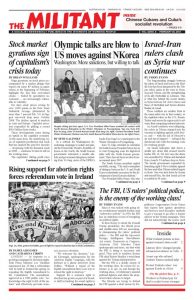Huge gyrations on stock prices accompanied by a market plunge that wiped out some $5 trillion in paper values at the beginning of February highlight the fact that overvalued stocks — fueled by speculative investment — are increasingly vulnerable to volatility.
For days stock prices swung by over 1,000 points as the Dow Jones Industrial Average plummeted by more than 7 percent Feb. 5-9, its biggest one-week drop since October 2008. The decline spread to markets in Asia and Europe. Capitalist investors responded by pulling a record $30.6 billion from stocks.
These developments come during an uptick in the capitalist economy. At the same time, the underlying crisis of capitalist production and trade that has marked the past few decades — deepening with the financial crash in 2008 — continues to take its toll on the working class.
The capitalists’ falling profit rates have led to a contraction in investment in capacity-expanding plant equipment and employment. Instead, the propertied owners have sought higher returns by speculating in stocks, bonds, derivatives and other forms of financial paper.
Among these “products” are a range of highly leveraged investments called exchange-traded funds and notes. Last week one of these notes — based on betting against volatility in stock prices — “went from being one of the world’s most lucrative investments in 2017 to being wiped out, and implosion rippled through global markets,” reported the Financial Times.
While the capitalist families and their meritocratic flacks watch the market gyrations with trepidation, workers continue to face crisis conditions. The uptick in capitalist production and hiring is good for workers and their self-confidence. More workers are finding or changing jobs, looking for higher pay and better conditions. But life is still hard for many.
While the official unemployment rate remains low at 4.1 percent, this figure doesn’t include millions of workers who’ve been eliminated from the workforce count because they’ve been out of work long-term. The so-called labor force participation rate — those employed or actively looking for work — was 62.7 percent in January, remaining near a 40-year low.
Some 5 million people wanting full-time work are employed part time, the Labor Department reports. The number of workers employed by contractors, getting less pay and benefits, increased to nearly 16 percent in 2015.
“Pay rises at fastest rate since 2009,” reported MarketWatch, up 2.9 percent from a year ago. Part of the increase comes from raises in the minimum wage that took effect in some 18 states in January. At the same time prices for goods at supermarkets are also rising.
Capitalist economists falsely argue that if productivity picks up, wages will too. But the government says productivity — which translates into speedup at the expense of safety — rose 75 percent between 1973 and 2013, while hourly pay only went up 9 percent. The federal minimum wage today would be more than $18 an hour — not the measly $7.25 it is — if it had “kept up” with productivity growth.
Median income lower than 1973
In fact, the inflation-adjusted median income for men who worked full time in 2016 was lower than it was in 1973.
In response to President Donald Trump’s tax cuts for the bosses and the even bigger profits they’re now reaping, some companies have offered one-time cash bonuses to their employees, like Walmart, Hostess Brands, Starbucks and Tyson Foods Inc. But Starbucks is giving stock, not cash, and Hostess is giving Twinkies and other snacks.
“A growing preference for one-time awards instead of raises that keep building over time has been quietly transforming the employment landscape for two decades,” the New York Timeswrote Feb. 10. You get a few more bucks, but your pay stays the same.
This shift has taken place as the bosses have fought to lower the number of workers organized by unions. In private industry today, only 6.5 percent of workers are unionized.
Workers are also saddled with record-high household debt, $13.1 trillion as of the end of 2017. Many workers depend on high-interest credit cards to get by.
Auto repossessions have also risen sharply. And some 2.5 million families are stuck with homes worth less than they owe on their mortgage.
Farmers have been hit especially hard by the capitalist crisis. Falling prices on their crops and stiffening worldwide competition have meant wheat and corn prices tumbled 50 percent since 2012. The U.S. Department of Agriculture forecasts that farm incomes will fall another 7 percent this year, meaning farm families will make less than half of what they made in 2013. Farmers are losing money and going deeper into debt, borrowing more and more to keep their farms running, in hopes things will eventually improve.

